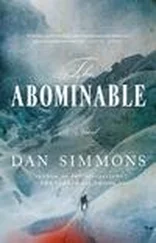Four of the five scouting expeditions returned with bad news and frostbitten feet, but Sir John waited most anxiously for Graham Gore’s return. Their last, best hope had always been to the southeast, toward King William Land.
Finally, on the third of June, ten days after Gore’s departure, lookouts from high in the masts called down that a sledge party was approaching from the southeast. Sir John finished his tea, dressed appropriately, and then joined the mob of men who’d rushed on deck to see what they could see.
The surface party was visible even by men on deck now, and when Sir John lifted his beautiful brass telescope – a gift from the officers and men of a twenty-six-gun frigate Franklin had commanded in the Mediterranean more than fifteen years earlier – one glance explained the lookouts’ audible confusion.
At first glance all seemed well. Five men were pulling the sledge, just as during Gore’s departure. Three figures were running alongside or behind the sledge, just as on the day Gore left. All eight accounted for then.
And yet…
One of the running figures did not appear to be human. At a distance of more than a mile and glimpsed between the seracs and ice-rubble upthrusts that had once been the placid sea here, it looked as if a small, round, headless but very furry animal was running behind the sledge.
And worse, Sir John could not make out Graham Gore’s distinctive tall figure in the lead nor the dashing red comforter he sported. All of the other figures hauling or running – and certainly the lieutenant would not have been hauling the sledge while his subordinates were fit – seemed too short, too bent, and too inferior .
Worst of all, the sledge seemed far too heavily packed for the return trip – the rations had included a week’s extra canned goods, but they were already three days over the estimated maximum round-trip time. For a minute Sir John’s hopes soared as he considered the possibility that the men had killed some caribou or other large land animals and were bringing in fresh meat, but then the distant forms emerged from behind the last large pressure ridge, still more than half a mile away across the ice, and Sir John’s telescope revealed something horrible.
Not caribou meat on the sledge, but what appeared to be two dead human bodies lashed atop the gear, one man stacked atop the other in a callous fashion that could only mean death. Sir John could now plainly make out two exposed heads, one at each end of the stack, with the head belonging to the body on top showing long white hair the likes of which no man aboard either ship possessed.
They were rigging ropes down the side of the canted Erebus to aid their portly captain’s descent onto the steep ice there. Sir John went belowdecks only long enough to add his ceremonial sword to his uniform. Then, pulling his cold-weather slops on over uniform, medals, and sword, he went up on deck and then over the side – puffing and wheezing, allowing his steward to help him down the slope – to greet whoever or whatever was approaching his ship.
Lat. 69° 37′ 42″ Long. 98° 41′
King William Land, 24 May-3 June, 1847
One reason that Dr. Harry D. S. Goodsir had insisted on coming along on this exploration party was to prove that he was as strong and able a man as most of his crewmates. He soon realized that he wasn’t.
On the first day, he had insisted – over the quiet objections of Lieutenant Gore and Mr. Des Voeux – on taking his turn at man-hauling the sledge, allowing one of the five crewmen so assigned to take a break and walk alongside.
Goodsir almost could not do it. The leather-and-cotton harness the sailmakers and pursers had constructed, cleverly attached to the pull ropes by a knot the sailors could tie or undo in a second and which Goodsir could not figure out for the life of him, was too large for his narrow shoulders and sunken chest. Even by cinching the front girth of the harness as tight as it would go, it slipped on him. And he, in turn, slipped on the ice, falling repeatedly, forcing the other men off their stride of pull, pause, gasp, pull. Dr. Goodsir had not worn such issued ice boots before and the nails driven through the soles caused him to trip over his own feet.
He had trouble seeing out of the heavy wire-mesh goggles, but when he raised them to his forehead, the glare of arctic sun on arctic ice half-blinded him within minutes. He’d put on too many layers, and now several of those layers of wool were so soaked with his own sweat that he was shivering even while being overheated by the extraordinary exertion. The harness pinched on nerves and cut off circulation to his thin arms and cold hands. He kept dropping his outer mittens. His panting and gasping grew so loud and constant that he was ashamed.
After an hour of such absurdity, Bobby Ferrier, Tommy Hartnell, John Morfin, and Marine Private Bill Pilkington – the other men in harness, Charles Best walking alongside now – each pausing to brush the snow off his anorak, looking at one another but saying nothing, of him never finding the rhythm of literally working in harness with others, he accepted the offer of relief from Best and, during one of the brief stops, slipped out of the harness and let the true men pull the heavy, high-mounted sledge with its wooden runners that constantly wanted to freeze to the ice.
Goodsir was exhausted. It was still morning of the first day on the ice, and he was so tired out from the hour of pulling that he could have happily unfurled his sleeping bag, set it on one of the wolfskin blanket robes, and gone to sleep until the next day.
And this was before they reached the first real pressure ridge.
The ridges to the southeast of the ship were the lowest in sight for the first two miles or so, almost as if the beset Terror herself had somehow kept the ice smoother in her lee, forcing the ridges farther away. But by late afternoon of the first day, the real pressure ridges rose up to block them. These were taller than those that had separated the two ships during their winter in the ice here, as if the pressures under the ice closer to King William Land were more terrible.
For the first three ridges, Gore led them southwest to find low spots, dips in the ridges where they could clamber over without too much difficulty. It added miles and hours to their travel but was still an easier solution than unpacking the sledge. There was no going around the fourth ridge.
Every pause of more than a few minutes meant that one of the men – usually young Hartnell – had to remove one of the many bottles of pyroligneous fuel from the carefully lashed mass on the sled, fire up a small spirit stove, and melt some snow in a pan into hot water, not to drink – to quench their thirst they had flasks they kept under their outer garments to keep from freezing – but to pour the warm water the length of the wooden runners so as to free them from the self-freezing ruts they dug in the scrim of icy snow.
Nor did the sledge move across the ice like the sleds and sleighs Goodsir had known from his moderately privileged childhood. He’d discovered on his first forays onto the pack ice almost two years ago that one could not – even in regular boots – take a run across the ice and slide the way one did at home on a frozen river or lake. Some property of the sea ice – almost certainly the high salt content – increased the friction, reducing the ease of sliding to almost nil. A mild disappointment for a running man wishing to slide like a boy, but a huge increase in effort for a team of men trying to pull, push, and generally man-haul many hundreds of pounds of gear piled high on more hundreds of pounds of sledge across such ice.
Читать дальше












